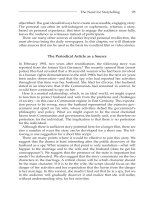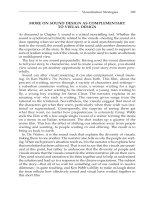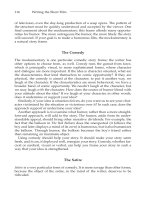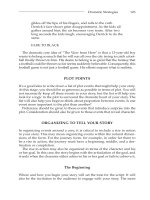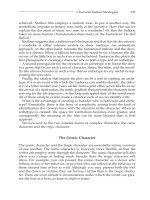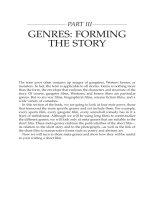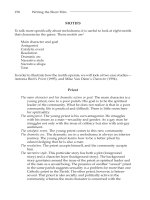Writing the short film 3th - Part 18
Bạn đang xem bản rút gọn của tài liệu. Xem và tải ngay bản đầy đủ của tài liệu tại đây (145.67 KB, 7 trang )
MORE ON SOUND DESIGN AS COMPLEMENTARY
TO VISUAL DESIGN
As discussed in Chapter 3, sound is a critical storytelling tool. Whether the
sound is synchronized (directly related to the visuals—hearing the sound of a
door opening when we see the door open) or is used asynchronously (in con-
trast to the visual), the overall pattern of the sound adds another dimension to
the experience of the story. In this way, the sound can be used to support an
aura of realism arising out of the visuals, or it can be used to create an alternate
or multilayered view.
The key is to use sound purposefully. Having used the visual dimension
to tell your story, to characterize, and to create a sense of place, you should
view sound as yet another opportunity to tell your story even more pow-
erfully.
Sound can alter visual meaning; it can also complement visual mean-
ing. In Ken Webb’s The Waiters, sound does both. This film, about the
process of waiting, moves through a variety of characters and settings—
a suburban commuter waiting for a train, a woman waiting for a sign
from above, an actor waiting to be discovered, a young man waiting to
fly, a young boy waiting for Santa Claus. The narrator explains in an
amusing way why each is waiting. The reasons given range from the
rational to the irrational. Nevertheless, the visuals suggest that most of
the characters get what they want, particularly when their wish was irra-
tional or supernatural. Consequently, the surprise of seeing them get
what they want, no matter how preposterous, is extremely funny. Webb
ends the film with a low-angle single visual of a waiter reciting the items
on a menu in an Italian restaurant. The shot makes up a quarter of the
entire film. This has the effect of shifting our attention away from people
waiting and wanting, to people waiting on and offering. The result is to
bring us back to earth.
In The Waiters, it is the sound track that explains the diversity of visuals,
linking them to one another. The narrator also tells us why the people are wait-
ing. When each person’s situation resolves, it is the narrator who explains how
that resolution has been achieved. That is not to say that the visuals are unnat-
ural at this point, but rather to underscore that the diversity of people and
visuals means that the visuals cannot do the entire narrative job on their own.
They need sound and narration to tie them together and to help us understand
the solution and lead us to a response to the diverse expectations. The subtext
of the story—that all of us wait for something out of our control to resolve
dilemmas—is quite touching, and Ken Webb’s ability to make us laugh about
the issue reflects how effectively sound and visual have worked together in
this short film.
Visualization Strategies 109
Ch09.qxd 9/27/04 6:07 PM Page 109
FORMAT
The format that you use can emphasize the importance of the visual in your
script. As discussed earlier, we suggest the widely used master scene format,
an example of which follows:
Title
By
For_______________
(TV program or production company)
1. It is raining, a thunderstorm. A young man,
Brad, walks to his mailbox. He opens the box with
much anticipation. He opens it. The rain is falling
like a sheet. He can barely read, but he notices the
words “pleased to offer you.” He stuffs the letter
into his pocket and begins to run.
BRAD
Mom! Dad! I’m in! I’m in!
He runs and is lost in the hail that begins, but we can
hear his voice. Brad is a happy man.
Cut to:
2. Int. Kitchen. Day.
Brad’s Mother is stirring the soup. He is soaked to the
skin.
MOTHER
You’d better get out of those clothes or you
won’t live long enough to go to that fancy school.
BRAD
It’s not fancy. It’s just good.
MOTHER
Good and fancy.
BRAD
Good.
110 Writing the Short Film
Ch09.qxd 9/27/04 6:07 PM Page 110
MOTHER
They won’t make you soup like this.
BRAD
You can mail me some every week.
MOTHER
Now you’re making fun of me.
Wait till you’re up there. You’ll probably think of
me and your dad as sources for your humor. I
hope you won’t forget us, Brad.
BRAD
I haven’t left yet, Mom.
MOTHER
And don’t forget where you came from, son,
don’t forget.
End of Scene 2
What is notable about the master scene format is that it is organized so
that the reader can visualize the story as easily as possible. There are no cam-
era angles, no detailed technical instructions, only description and dialogue.
You should acquaint yourself with the format and use it to develop your
own short screenplay.
EXERCISE 17
In this 10-minute writing exercise, write as fast as you can without stopping
to think or worry about logic, spelling, or punctuation. Use a timer and try
not to look at it.
1. Place a picture in front of you. Imagine the picture as a freeze-frame.
Imagine that the character in the picture begins an action. Write for
10 minutes. Then put aside your work without reading it.
2. Do the same with a second picture.
3. Now list 10 sounds that are particularly evocative for you.
4. Make a list of five sounds that could establish the feeling-tone of the
first picture.
5. Make a list of five sounds that could establish the feeling-tone of the
second picture. Note that silence is also a “sound.”
Visualization Strategies 111
Ch09.qxd 9/27/04 6:07 PM Page 111
Ch09.qxd 9/27/04 6:07 PM Page 112
10
DRAMATIC
STRATEGIES
You have an idea for your story, and the problem before you is to find the
drama in your idea and shape it into a film script.
Something about the idea, which may have come from any one of the
sources mentioned in Chapter 6, has captured your imagination and
unlocked an emotional reaction. Whether it touches your unconscious or
conscious synapses, the deed is done, and the idea seems to haunt you. It
won’t go away until you convert it into a script, and from a script into a film
that you can share with others. The film gives others an insight into you: it’s
a gift to them and an invitation to join with you for the length of the film
experience. These are the motivations for converting an idea into a dramatic
story. We turn now to the means to achieve that transformation.
THE IDEA
At the beginning of the process of developing an idea into a dramatic
story, it’s important to consider a number of questions whose answers will
direct you.
First, does the idea have only the shape of a photograph, or does it have
an implied narrative? The observation or photograph of a young girl rush-
ing down the wintry street carrying her winter coat and a knapsack implies
that she is going to school. Will the story be shaped around the events of this
day at school? Is there something special about this day? Or is it simply an
ode to the freedom of being 16 and having no greater obligation than to join
your friends at school?
If the idea or observation does not suggest a direction, it is important to
decide what it is about the image that stays with you. Let’s decide that it is
113
Ch10.qxd 9/27/04 6:07 PM Page 113
